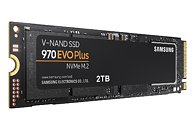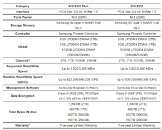Tuesday, January 22nd 2019

Samsung Launches the 970 EVO Plus NVMe SSD Family
Samsung today introduced the Samsung 970 EVO Plus, the newest enhancement in its Non-Volatile Memory Express (NVMe) SSD portfolio. With industry-leading performance and up to two terabytes in capacity, Samsung's 970 EVO Plus sets a new bar for high-performance storage, enabling IT professionals, tech enthusiasts and gamers to handle intensive workloads on PCs and workstations with more ease.
"Since introducing the first NVMe SSDs to the consumer market in 2015, Samsung has continued to challenge technical barriers in SSD design and performance," said Dr. Mike Mang, vice president of Brand Product Marketing, Memory Business at Samsung Electronics. "The new 970 EVO Plus powered by Samsung's latest fifth-generation V-NAND technology will now offer unrivaled performance in its class when taking on demanding tasks like 4K content editing, 3D modeling and simulation as well as heavy gaming."By integrating the company's most advanced V-NAND chips with optimized firmware, the 970 EVO Plus achieves significant performance improvements - up to 53 percent in write speed - as well as increased power efficiency over its predecessor, the 970 EVO. The new drive delivers sequential read and write speeds of up to 3,500 megabytes per second (MB/s) and up to 3,300 MB/s, respectively, while random speeds come in at up to 620,000 IOPS for read and up to 560,000 IOPS for write operations.
Users can easily upgrade their devices as the 970 EVO Plus comes in a compact M.2 form factor using the PCIe Gen3 x4 interface found in most modern computers. The 970 EVO Plus also offers a five-year limited warranty or up to 1,200 terabytes written.
The 970 EVO Plus comes in a variety of capacity options; the 250 GB, 500 GB and 1 TB capacity versions are now available for purchase worldwide, and the 2TB capacity will become available in April.
"Since introducing the first NVMe SSDs to the consumer market in 2015, Samsung has continued to challenge technical barriers in SSD design and performance," said Dr. Mike Mang, vice president of Brand Product Marketing, Memory Business at Samsung Electronics. "The new 970 EVO Plus powered by Samsung's latest fifth-generation V-NAND technology will now offer unrivaled performance in its class when taking on demanding tasks like 4K content editing, 3D modeling and simulation as well as heavy gaming."By integrating the company's most advanced V-NAND chips with optimized firmware, the 970 EVO Plus achieves significant performance improvements - up to 53 percent in write speed - as well as increased power efficiency over its predecessor, the 970 EVO. The new drive delivers sequential read and write speeds of up to 3,500 megabytes per second (MB/s) and up to 3,300 MB/s, respectively, while random speeds come in at up to 620,000 IOPS for read and up to 560,000 IOPS for write operations.
Users can easily upgrade their devices as the 970 EVO Plus comes in a compact M.2 form factor using the PCIe Gen3 x4 interface found in most modern computers. The 970 EVO Plus also offers a five-year limited warranty or up to 1,200 terabytes written.
The 970 EVO Plus comes in a variety of capacity options; the 250 GB, 500 GB and 1 TB capacity versions are now available for purchase worldwide, and the 2TB capacity will become available in April.


57 Comments on Samsung Launches the 970 EVO Plus NVMe SSD Family
i added my system specs as an FYI
(I live in EU and samsung drives are quite reasonably priced compared to competition)
NVMe drives have their use, and definite value, but the faster you get, the smaller the returns in terms of noticeable speed-ups become. Capacity definitely matters a lot more than absolute performance as soon as you exceed 1500-2000MB/s sequential speeds and 2x SATA IOPS. I got a 960 Evo as much for convenience (no cabling, small, unobtrusive) as for the performance, even if my boot times did improve somewhat from my previous 840 Pro boot drive.
<Tongue in cheek comment BTW!>
What exact drives were you swapping?
Boot speed is kind of irrelevant, if it's 15 seconds or 30 most folks won't notice. 1-2 mins versus 20 seconds is another matter. :)